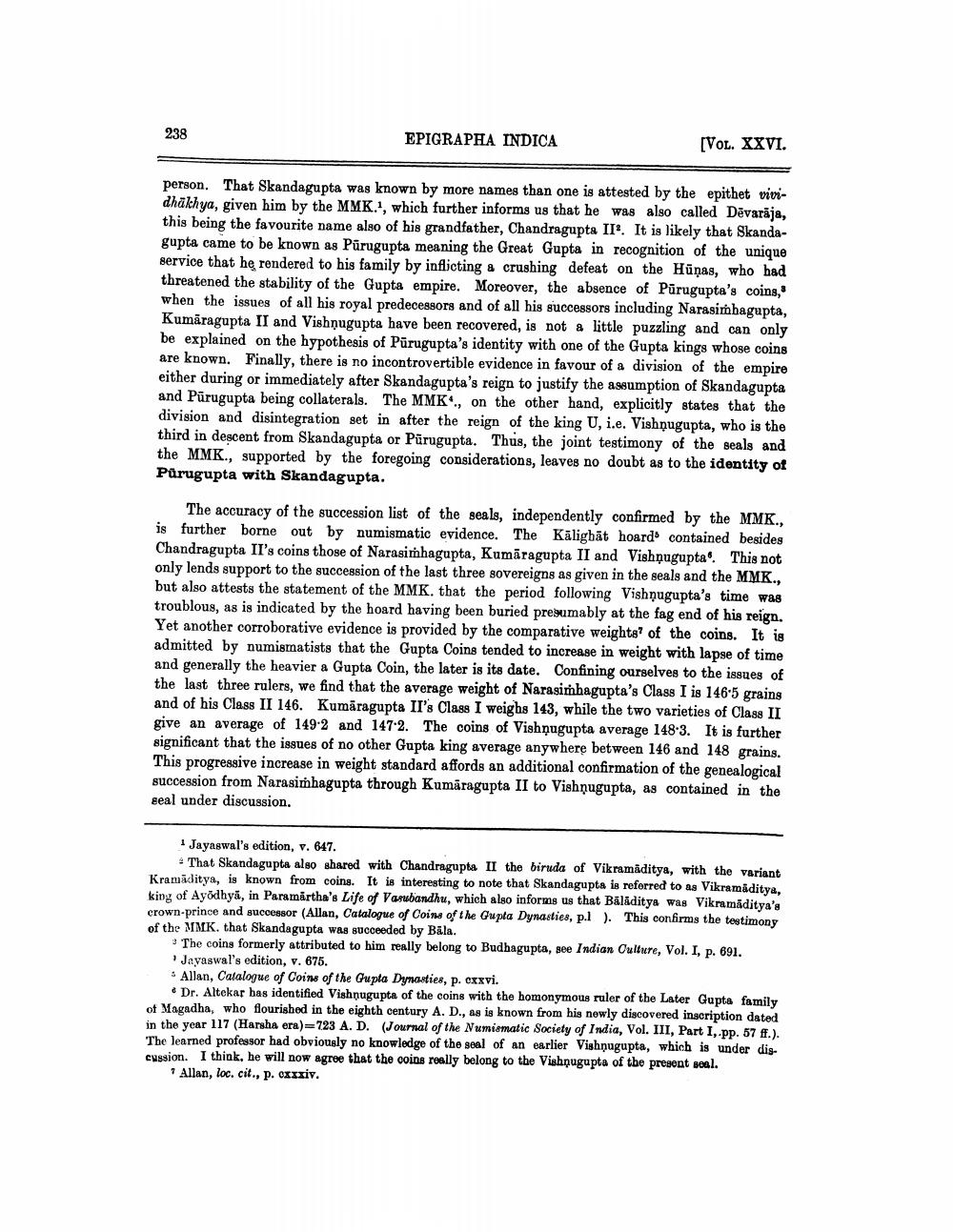________________
238
EPIGRAPHA INDICA
[VOL. XXVI.
person. That Skandagupta was known by more names than one is attested by the epithet vividhälehya, given him by the MMK., which further informs us that he was also called Devarāja, this being the favourite name also of his grandfather, Chandragupta II°. It is likely that Skandagupta came to be known as Pūrugupta meaning the Great Gupta in recognition of the unique service that he rendered to his family by inflicting a crushing defeat on the Hūņas, who had threatened the stability of the Gupta empire. Moreover, the absence of Pūrugupta's coins, when the issues of all his royal predecessors and of all his successors including Narasimbagupta, Kumāragupta II and Vishnugupta have been recovered, is not a little puzzling and can only be explained on the hypothesis of Pūrugupta's identity with one of the Gupta kings whose coins are known. Finally, there is no incontrovertible evidence in favour of a division of the empire either during or immediately after Skandagupta's reign to justify the assumption of Skandagupta and Pūrugupta being collaterals. The MMK., on the other hand, explicitly states that the division and disintegration set in after the reign of the king U, i.e. Vishộugupta, who is the third in descent from Skandagupta or Pūrugupta. Thus, the joint testimony of the seals and the MMK., supported by the foregoing considerations, leaves no doubt as to the identity of Purugupta with Skandagupta.
The accuracy of the succession list of the seals, independently confirmed by the MMK., is further borne out by numismatic evidence. The Kālighāt hoards contained besides Chandragupta II's coins those of Narasimhagupta, Kumāragupta II and Vishnugupta. This not only lends support to the succession of the last three sovereigns as given in the seals and the MMK., but also attests the statement of the MMK. that the period following Vishộugupta's time was troublous, as is indicated by the hoard having been buried presumably at the fag end of his reign. Yet another corroborative evidence is provided by the comparative weights of the coins. It is admitted by numismatists that the Gupta Coins tended to increase in weight with lapse of time and generally the heavier a Gupta Coin, the later is its date. Confining ourselves to the issues of the last three rulers, we find that the average weight of Narasimhagupta's Class I is 1465 grains and of his Class II 146. Kumāragupta II's Class I weighs 143, while the two varieties of Class II give an average of 149-2 and 147-2. The coins of Vishnugupta average 148-3. It is further significant that the issues of no other Gupta king average anywhere between 146 and 148 grains. This progressive increase in weight standard affords an additional confirmation of the genealogical succession from Narasimhagupta through Kumāragupta II to Vishnugupta, as contained in the seal under discussion.
Jayagwal's edition, v. 647.
* That Skandagupta also shared with Chandragupta II the biruda of Vikramaditya, with the variant Kramaditya, is known from coins. It is interesting to note that Skandagupta is referred to as Vikramaditya, king of Ayodhyā, in Paramartha's Life of Vasubandhu, which also informs us that Baláditya Was Vikramaditya's crown-prince and successor (Allan, Catalogue of Coins of the Gupta Dynasties, p.1 ). This confirms the testimony of the MMK, that Skandagupta was succeeded by Bala.
The coins formerly attributed to him really belong to Budhagupta, gee Indian Culture, Vol. I, p. 691. Jayaswal's edition, v. 675. • Allan, Catalogue of Coins of the Gupla Dynasties, p. cxxvi.
• Dr. Altekar has identified Vishnugupta of the coins with the homonymous ruler of the Later Gupta family of Magadha, who flourished in the eighth century A. D., as is known from his newly discovered inscription dated in the year 117 (Harsha era)-723 A. D. (Journal of the Numismatic Society of India, Vol. III, Part I, pp. 57 ff.). The learned professor had obviously no knowledge of the seal of an earlier Vishnugupta, which is under discussion. I think, he will now agree that the coins really belong to the Vishnugupta of the present seal.
* Allan, loc. cit., p. cxxxiv.




